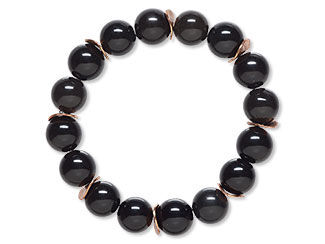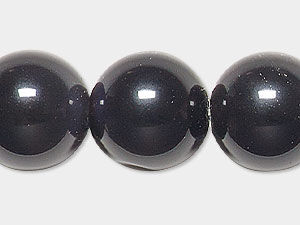Obsidian, Rainbow Meaning and Properties
Rainbow Obsidian History
Obsidian is a naturally occurring volcanic glass that has been used by human beings around the world for thousands of years as a gemstone, tool and weapon. Obsidian was a valuable material in all Mesoamerican cultures, from the pre-historic Olmecs all the way up the Aztecs meeting the conquistadors in the 1600s. Polynesian cultures used obsidian for food preparation—and probably for tattooing. Meanwhile, in southern Europe, the Minoans, Greeks and Romans used obsidian as mirrors, cups, home décor and, naturally, for beads!
Obsidian gets its English name from a mistranslation of Natural History by Pliny the Elder (the guy who died at Pompeii):
"Among the various kinds of glass, we may also reckon Obsian glass, a substance very similar to the stone which Obsius [mistranslated as Obsidius] discovered in Æthiopia. This stone is of a very dark color, and sometimes transparent ... Many persons use it for jewelery, and I myself have seen solid statues in this material of the late Emperor Augustus .... Xenocrates says that Obsian stone is found in India also, and in Samnium in Italy; and that it is a natural product of Spain, upon the coasts which border on the Ocean."
Rainbow obsidian (also called "iridescent obsidian," "fire obsidian" or "eye of heaven") is a morphed version of black obsidian. Nanoparticle inclusions of magnetite diffract light, create the shimmering purple, blue, green and bronze color effects.
Rainbow Obsidian Metaphysical Properties
For believers in the metaphysical, rainbow obsidian is believed to be a stone of openness, encouragement and reclamation. It has been affiliated with the root chakra and the zodiacal sign of Libra.
It is said to be a stone that says "Yes, AND" to every aspect the wearer is working on. Rainbow obsidian is the friend who joins you to push the car out of the ditch, the one who knows what to do when you’re down—and also the one who reminds you to get your head back in the game if you get distracted.
Among some practitioners, rainbow obsidian is used for meditation and memory work, as it is believed to soften the edges of pain accumulated from previous trauma
Rainbow Obsidian Geological Properties
Formed when lava rich in feldspar and quartz cools too rapidly for crystals to form, obsidian is not classified as a true mineral. This is because its composition is too variable and, as a glass, it lacks a crystalline structure, distinguishing it from other igneous rocks.
Obsidian can be found wherever volcanic activity has occurred, with some of the most notable sources today being South America, Mexico and multiple locations in the United States. Rainbow obsidian is found in many of those sources, but the best deposits are in Mexico and Armenia.
This hard, brittle and glossy volcanic glass was historically knapped when used for tools and weapons. Knapping is a time-intensive process and quality control is difficult, so metal has been long preferred for both. However, obsidian is renowned for its exceptionally sharp cutting edge, which is nearly five times sharper than highly refined steel and at least ten times thinner than a razor blade. For certain types of surgery, doctors prefer obsidian scalpels, since their edges can be a single molecule wide and cuts made by obsidian heal faster and scar less.
|
|
|
|
|
Varies |
|
|
|
|
|
|
|
|
|
|
|
|
Proper Care of Rainbow Obsidian
Rainbow obsidian can be safely cleaned using a soft cloth and soapy water to remove any traces of body oils or perspiration. Avoid using ultrasonic or steam cleaners. Soap residue can build up on it, so rinse well and polish after. If the piece has sharp edges, do this slowly and carefully, as obsidian edges can cut skin painlessly. Take care to store rainbow obsidian in a soft case away from hard objects, since the mid-range Mohs hardness means it can be easily scratched.
Designing with Rainbow Obsidian
Rainbow obsidian’s color display make it an excellent choice for a wide range of jewelry types. Like other obsidians, rainbow obsidian is a volcanic glass. This means it is brittle and cleaves when struck with a sharp blow, leaving a sharp edge behind. This makes rainbow obsidian better suited for jewelry pieces like earrings and brooches, which are less prone to the impacts that necklaces, bracelets and anklets often experience.
Rainbow obsidian’s subtle iridescence can be overwhelmed by bold color combinations. While available in a range of sizes, large cabochons—smooth, rounded stones without facets—and flat beads showcase its beauty best. It is often carved into heart-shape cabochons to take advantage of the rainbow effect.
Depending on the colors in the stone, it can be stylishly paired with cool- or warm-tone metals, including steel and bronze. Remove obsidian jewelry before engaging in physical activity.
A Few Design Inspirations to Get You Started
Shop for Rainbow Obsidian
**Please note that all metaphysical or healing properties listed are collected from various sources. This information is offered as a service and not meant to treat medical conditions. Fire Mountain Gems and Beads® does not guarantee the validity of any of these statements.
How did you like this resource? Your feedback helps us provide resources that matter to you most.
Copyright Permissions
All works of authorship (articles, videos, tutorials and other creative works) are from the Fire Mountain Gems and Beads® Collection, and permission to copy is granted for non-commercial educational purposes only. All other reproduction requires written permission. For more information, please email copyrightpermission@firemtn.com.




